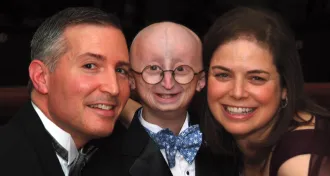
Senior writer Tina Hesman Saey is a geneticist-turned-science writer who covers all things microscopic and a few too big to be viewed under a microscope. She is an honors graduate of the University of Nebraska-Lincoln where she did research on tobacco plants and ethanol-producing bacteria. She spent a year as a Fulbright scholar at the Georg-August University in Göttingen, Germany, studying microbiology and traveling. Her work on how yeast turn on and off one gene earned her a Ph.D. in molecular genetics at Washington University in St. Louis. Tina then rounded out her degree collection with a master’s in science journalism from Boston University. She interned at the Dallas Morning News and Science News before returning to St. Louis to cover biotechnology, genetics and medical science for the St. Louis Post-Dispatch. After a seven year stint as a newspaper reporter, she returned to Science News. Her work has been honored by the National Academies of Sciences, Engineering and Medicine, the Endocrine Society, the Genetics Society of America and by journalism organizations.

Trustworthy journalism comes at a price.
Scientists and journalists share a core belief in questioning, observing and verifying to reach the truth. Science News reports on crucial research and discovery across science disciplines. We need your financial support to make it happen – every contribution makes a difference.
All Stories by Tina Hesman Saey
-
 Life
LifeBedbugs raise genetic defense against pesticides
Bedbugs turn on several genes, in both their shells and their nerve cells, to stave off effects of insecticides.
-
 Life
LifeNew virus uses protein handle to infect cells
Deadly coronavirus related to SARS attaches to protein on cells unlike the one SARS uses.
-
 Life
LifeTasmanian devil disease reveals its secrets
The contagious cancer evades the animal’s immune system by turning off key genes.
-
 Life
LifeAlga borrows genes to beat the heat, acid and toxic metals
Such genetic theft from bacteria and archaea is unusual among eukaryotes.
-
 Life
LifeMice get brain boost from transplanted human tissue
An experimental transplant of what have long been considered just support cells shows they may play a role in memory and learning.
-
 Neuroscience
NeuroscienceTadpoles with eyes in their tails see the light
Transplanted eyes in the creature’s tail can distinguish between red and blue.
-
 Life
LifeScientists race to understand deadly new virus
Emerging virus causes severe illness, but doesn’t spread as quickly as SARS.
-
 Science & Society
Science & SocietyResearcher rehab
A project called RePAIR aims to help those who have engaged in misconduct or unprofessional behavior get a second chance.
-

-
 Life
LifeInsulin levels wax and wane daily
Modern life may clash with the hormone’s natural cycle, new mouse research suggests.
-
 Humans
HumansIn research, it matters whether you’re a man or a mouse
A study that compares trauma responses of mice with those in people questions the relevance of mouse research to human disease.
-
